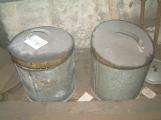1
This storyline will show you some of the over 1,500 artifacts that are on display at the Green Family Forge.All of these artifacts were left in the forge when it was closed in 1955 by the last blacksmith in the Green family, Andrew.
Upon restoration of the forge in 1991all of these artifacts were cleaned and dipped in a tannic acid preservative to clean off any rust and to prevent any further damage to the artifacts. This process is completed every couple of years.
3
A small barrel. Barrels would be made by a cooper and the hoops which are usually made from either iron or tin were made at the forge.Hoops could also be made from wood.
4
A 1951 Thompson and Sutherland calendarDecember, 1951
Green Family Forge,Trinity, Newfoundland and Labrador, Canada

5
When the forge was opened in 1990, the members of the Historical Society were very pleased to see all of the artifacts that were left there by the Green family.Among the artifacts were calendars that Andrew had collected over the years. Among the calendars was one from 1955, turned to the exact month when he closed his business, August.
6
A 1942 Sun Life Canada CalendarOctober, 1942
Green Family Forge,Trinity, Newfoundland and Labrador, Canada

8
While blacksmiths mostly work with iron some also made things out of tin, as did the Greens in their forge. At the back of the building was a tinsmithing section. Here stovepipes, roof flanges, oil cans, gasoline tanks, funnels, kettles, mixing pans, tea cans and many more items were made.9
Oil cans or commonly referred to as a feeders1940
Green Family Forge,Trinity, Newfoundland and Labrador, Canada

10
Oil cans like these would be made by the blacksmith in the tinsmithing section of the forge. Oil cans would be made in various sizes depending on how they would be used.The examples shown here would contain small amounts of oil that would be kept in a workshop area and used to grease engines, mechanical parts of tools etc.. larger oil cans would be used to carry larger amouts of oil that would have to be carried to a boat after being drained from a larger drum or tank.
11
Part of a stove funnel that was used on the back of wood stoves. Made from tin.1940
Green Family Forge,Trinity, Newfoundland and Labrador, Canada

12
Bending machine for pieces of tin.1900
Green Family Forge,Trinity, Newfoundland and Labrador, Canada



